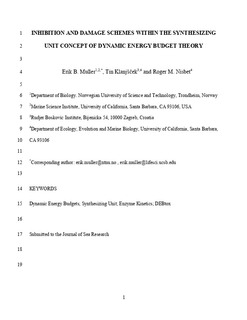| dc.contributor.author | Muller, Erik | |
| dc.contributor.author | Klanjšček, Tin | |
| dc.contributor.author | Nisbet, Roger M | |
| dc.date.accessioned | 2019-04-25T07:18:53Z | |
| dc.date.available | 2019-04-25T07:18:53Z | |
| dc.date.created | 2018-08-17T15:52:32Z | |
| dc.date.issued | 2018 | |
| dc.identifier.citation | Journal of Sea Research. 2018, 143 165-172. | nb_NO |
| dc.identifier.issn | 1385-1101 | |
| dc.identifier.uri | http://hdl.handle.net/11250/2595352 | |
| dc.description.abstract | Synthesizing Units (SU) concept plays an important role in organizing metabolism in Dynamic Energy Budget (DEB) theory. SUs are generalized units that bind and processes incoming streams of materials (substrates, generalized compounds, food, etc.) to yield one or more products. We use paradigms from enzyme kinetics to explore the impact of inhibitors and damaging agents on the dynamics of SUs requiring one or two substrates. Inhibitors interact reversibly with one or more SU states and thereby impede their functioning but otherwise do not have deleterious impact, whereas a damaging agent decommissions an SU, which then either needs to be replaced via de novo synthesis or to be repaired, implying the removal of any already bound substrate molecules. When substrate arrival rates are proportional to densities, single substrate SUs behave dynamically similar to their enzymatic counterparts; with a minor adjustment, this similarity holds when an inhibitor is present. The impact of a damaging agent on SU dynamics is similar to that of an inhibitor, if the mean time interval between damage events is long relative to the time it takes an SU with bound substrate to form a product. However, damage done to an SU with substrate(s) already bound implies an energetic loss if the substrate binding is an endergonic process. Those conclusions with single substrate SUs essentially carry over to SUs requiring two different substrates to form a product, though the mathematical formalisms involved are more complex. There are conceptual similarities between SUs subjected to damage or inhibition and individuals whose feeding activity is impeded by social interactions. Our formalism accounts for a marked variety of conceptual SUs, and types of inhibition and damage – ranging from enzymes and molecules to individuals and social interactions instigating a behavioral response. | nb_NO |
| dc.language.iso | eng | nb_NO |
| dc.publisher | Elsevier | nb_NO |
| dc.rights | Attribution-NonCommercial-NoDerivatives 4.0 Internasjonal | * |
| dc.rights.uri | http://creativecommons.org/licenses/by-nc-nd/4.0/deed.no | * |
| dc.title | Inhibition and damage schemes within the synthesizing unit concept of dynamic energy budget theory | nb_NO |
| dc.type | Journal article | nb_NO |
| dc.type | Peer reviewed | nb_NO |
| dc.description.version | acceptedVersion | nb_NO |
| dc.source.pagenumber | 165-172 | nb_NO |
| dc.source.volume | 143 | nb_NO |
| dc.source.journal | Journal of Sea Research | nb_NO |
| dc.identifier.doi | 10.1016/j.seares.2018.05.006 | |
| dc.identifier.cristin | 1602762 | |
| dc.description.localcode | © 2018. This is the authors’ accepted and refereed manuscript to the article. Locked until 18 May 2020 due to copyright restrictions. This manuscript version is made available under the CC-BY-NC-ND 4.0 license http://creativecommons.org/licenses/by-nc-nd/4.0/ | nb_NO |
| cristin.unitcode | 194,66,10,0 | |
| cristin.unitname | Institutt for biologi | |
| cristin.ispublished | true | |
| cristin.fulltext | postprint | |
| cristin.qualitycode | 1 | |

